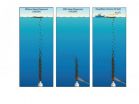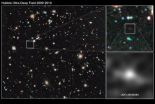(Press-News.org) Scientists are reporting that key chemical components of the 770,000 gallons of oil dispersants applied below the ocean surface in the Deepwater Horizon spill did mix with oil and gas spewing out of the damaged wellhead and remained in the deep ocean for two months or more without degrading. However, it was not possible to determine if the first deep ocean use of oil dispersants worked as planned in breaking up and dissipating the oil. Their study, the first peer-reviewed research published on the fate of oil dispersants added to underwater ocean environments, appears in ACS' journal Environmental Science & Technology.
Elizabeth Kujawinski and colleagues note ongoing concern about the environmental fate of the 1.4 million gallons of dispersant applied to the ocean surface and the 770,000 gallons of dispersant pumped to the mile-deep well head during the oil spill in the Gulf of Mexico. Many studies show that dispersants added to surface oil spills prevent them from coating and harming sensitive coastal environments, but no large-scale applications of dispersants in deep water had been conducted until the Deepwater Horizon oil spill. Thus, no data exists on the environmental fate of dispersants in deep water, the scientists say.
The scientists collected and analyzed seawater samples from the Gulf of Mexico for the presence of a key dispersant ingredient, called DOSS (dioctyl sodium sulfosuccinate), during the active oil flow and again after the flow had ceased. They found DOSS became concentrated in the deepwater plumes of suspended oil and gas at depths of up to three-quarters of a mile and did not mix with the surface applications of dispersant. They also detected the dispersant ingredient at distances of nearly 200 miles from the well two months after deepwater dispersant applications ceased, indicating it was not rapidly biodegraded. Their data is not sufficient to resolve whether the dispersant was effective in dispersing the oil coming out of the wellhead. However, the scientists argue that the persistence of the dispersant over long distances and time periods justifies further study of the effects of chemical dispersant and oil mixture exposure.
INFORMATION:
The authors acknowledge funding from the National Science Foundation, the Gordon and Betty Moore Foundation and from the Woods Hole Oceanographic Institution.
ARTICLE FOR IMMEDIATE RELEASE
"Fate of Dispersants Associated with the Deepwater Horizon Oil Spill"
Full Text available from: m_bernstein@acs.org
CONTACT:
Woods Hole Oceanographic Institution
News Media Office
508-289-3340
First report on fate of underwater dispersants in Deepwater Horizon oil spill
2011-01-27
ELSE PRESS RELEASES FROM THIS DATE:
Getting more anti-cancer medicine into the blood
2011-01-27
Scientists are reporting successful application of the technology used in home devices to clean jewelry, dentures, and other items to make anticancer drugs like tamoxifen and paclitaxel dissolve more easily in body fluids, so they can better fight the disease. The process, described in ACS' journal, Langmuir, can make other poorly soluble materials more soluble, and has potential for improving the performance of dyes, paints, rust-proofing agents and other products.
In the report, Yuri M. Lvov and colleagues point out that many drugs, including some of the most powerful ...
Fish smile but some consumers frown at new genre of phosphate-free detergents
2011-01-27
Phosphate-free automatic dishwashing detergents — introduced to combat the phosphate-fed algae blooms that foul the nation's lakes and rivers — may be making the fish happy. But they're putting a frown on the faces of some consumers who say the new products leave dishes dirty. That's the topic of the cover story in the current edition of Chemical & Engineering News (C&EN), ACS' weekly newsmagazine.
C&EN Assistant Managing Editor Michael McCoy described how new laws in 16 states require manufacturers to eliminate phosphates from automatic dishwasher detergents sold in ...
Hubble finds a new contender for galaxy distance record
2011-01-27
Astronomers have pushed the NASA/ESA Hubble Space Telescope to its limits by finding what is plausibly the most distant and ancient object in the Universe [1] ever seen. Its light has travelled for 13.2 billion years to reach Hubble [2], which corresponds to a redshift around 10. The age of the Universe is 13.7 billion years.
The dim object, called UDFj-39546284, is likely to be a compact galaxy of blue stars that existed 480 million years after the Big Bang, only four percent of the Universe's current age. It is tiny. Over one hundred such mini-galaxies would be needed ...
Shockable cardiac arrests are more common in public than home
2011-01-27
Cardiac arrests that can be treated by electric stimulation, also known as shockable arrests, were found at a higher frequency in public settings than in the home, according to a National Institutes of Health-funded study appearing in the Jan. 27 issue of the New England Journal of Medicine.
The study compared home and public cardiac arrests under various scenarios. For example, the study considered whether bystanders or emergency medical services (EMS) personnel witnessed the cardiac arrest, and whether the person experiencing the arrest received treatment with an automatic ...
Hubble sees farther back in time than ever before
2011-01-27
Pasadena, CA— Astronomers have pushed NASA's Hubble Space Telescope to it limits by finding what they believe to be the most distant object ever seen in the universe—at a distance of 13.2 billion light years, some 3% of the age of universe. This places the object roughly 150 million light years more distant than the previous record holder. The observations provide the best insights yet into the birth of the first stars and galaxies and the evolution of the universe. The research is published in the 27th January edition of Nature.
The dim object is a compact galaxy made ...
NASA's Aqua Satellite sees Tropical Depression Anthony heading toward Australia
2011-01-27
NASA's Aqua Satellite captured a visible image of the former Tropical Storm Anthony, now weakened to a tropical depression, but forecasters aren't counting Anthony out yet. Despite its weakened condition Anthony continues to move west toward Queensland, Australia and into a more favorable area for sustaining a tropical cyclone.
The Atmospheric Infrared Sounder (AIRS) instrument that flies aboard NASA's Aqua satellite captured a visible image on Jan. 26 at 03:23 UTC of Tropical Depression Anthony in the South Pacific Ocean. The image revealed a cloud-filled center of the ...
NASA's TRMM Satellite sees TD10S strengthen into Tropical Storm Bianca
2011-01-27
The life of a cyclone is a complex one, and NASA satellites have kept track of a low that has now become Tropical Storm Bianca just off the northern coast of Western Australia.
What began as a low pressure system designated as System 98S on January 24, brought rains near Kuri Bay, Australia. On January 25, System 98S strengthened into the tenth tropical depression of the Southern Pacific Ocean hurricane season and was designated as "10S." Today, January 26, that low intensified into a tropical storm and was named Bianca.
NASA's Tropical Rainfall Measuring Mission (TRMM) ...
Gender and hygiene: Could cleanliness be hurting girls?
2011-01-27
CORVALLIS, Ore. – Little girls growing up in western society are expected to be neat and tidy – "all ribbon and curls" – and one researcher who studies science and gender differences thinks that emphasis may contribute to higher rates of certain diseases in adult women.
The link between increased hygiene and sanitation and higher rates of asthma, allergies and autoimmune disorders is known as the "hygiene hypothesis" and the link is well-documented. Yet the role of gender is rarely explored as part of this phenomenon.
Oregon State University philosopher Sharyn Clough ...
Food-borne bacteria causes potentially fatal heart infection
2011-01-27
Researchers at the University of Illinois at Chicago College of Medicine have found that particular strains of a food-borne bacteria are able to invade the heart, leading to serious and difficult-to-treat heart infections.
The study is available online in the Journal of Medical Microbiology.
The bacteria Listeria monocytogenes is commonly found in soft cheeses and chilled ready-to-eat products. For healthy individuals, listeria infections are usually mild, but for susceptible individuals and the elderly, infection can result in serious illness, usually associated with ...
President Obama calls for increased investment in science, including biomedical research
2011-01-27
Bethesda, MD - Last night, in his State of the Union address, President Barack Obama presented the nation with a vision of a better future through investment in education, infrastructure, and research. Recognizing the role that innovation has played in this nation's history and the promise that it holds for addressing the many challenges we face, he stated that "maintaining our leadership in research and technology is crucial to America's success."
William T. Talman, MD, President of the Federation of American Societies for Experimental Biology (FASEB) responded, "we ...




